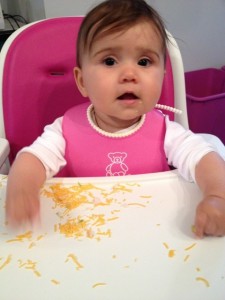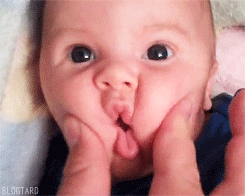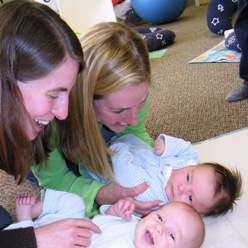
Are you moving from spoon-feeding purees to starting to offer bits and pieces of food? Here are some tips that address common questions new parents may have during this transition.
1. Not so big. Bits of food for self-feeding should be about the size of your baby’s thumbnail, or smaller than a dime. Bits of toast, waffles, pancakes, French toast, grilled cheese sandwiches and muffin bits are usually well-received by babies and are easy foods for them to manage.
2. Nothing hard, sticky or chewy. Hard foods like raw carrots or apples can be sliced then steamed before offering. Raisins may be soaked in hot water to soften.
3. Avoid round foods and coin-shaped slices. Foods like grapes, steamed carrots, string cheese sticks, hot dogs (a whole other can of worms) should be chopped small to reduce the risk of choking.
4. Teeth aren’t needed to chew. As long as the foods you offer are soft enough for you to to squish between your thumb and forefinger, your child should be able to chew them just fine with his gums even without molars.
5. Offer a preloaded fork or spoon if your child is eager to feed himself. Reduce frustration by using foods that stick to the spoon (like yogurt) rather than foods that drip off (like soup). Soft cooked elbow macaroni makes a good introduction to fork feeding.
6. If your baby stuffs too much in his mouth at once (or throws it all on the floor), just offer a few bits on the tray at a time and add more pieces after the first few are eaten.
7. Skip the kids’ menu at restaurants. Offer bits of chicken, baked fish, meatball, potato, rice, pasta, steamed vegetables, baked beans, roll. Make steak “shavings” by scraping at the surface of the steak with a knife.
8. Say “cheese”. Shredded mozzarella or Monterey Jack cheese in the zip-seal pouches (called “bag cheese” in my house) sprinkled on the highchair tray is a speedy snack that can keep a snacking baby busy for awhile.
9. It’s okay to help. Your baby does need to learn how to feed herself, but it’s okay to pop in a bite here and there or spoon feed purees or mashed food in addition to foods your baby picks up.
10. Sensory-Sensitive. Some babies are especially sensitive to the sensation of textures or dislike having their hands dirty. Use dry foods like toast bits, rice cakes or cereal rather than mushy food like banana slices to practice finger-feeding and hand-eye coordination.
Bonus: Respect your baby’s cues and don’t try to push in more food than your baby wants. “One more bite” really won’t make any difference in terms of your child’s nutrition


